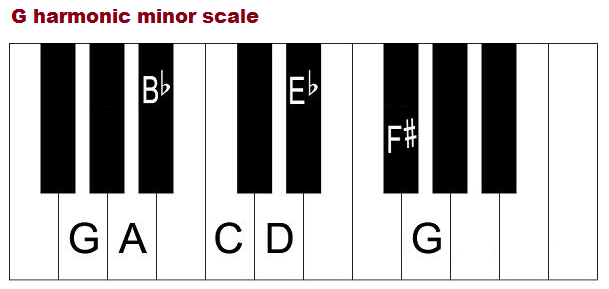

It works over all three chords and has a strong sense of tonality and unity. The harmonic minor is perfect for generating hip II-V-I lines because it has the b9 and b13 of the V7 chord embedded in it and it allows you to simplify the entire II-V-I into one single reductive scale. When you use this scale over a minor II-V-I in C minor, you end up with a D Locrian (natural 6) scale over the II (half dim.) chord, a G Phrygian (natural 3) scale over the V7 chord, and C Aeolian (natural 7) – the tonic harmonic minor – over the I- chord. You can read my recent post for a recap of what the harmonic minor scale is and how it’s derived. The harmonic minor scale is used a lot in jazz, especially in vocabulary from the bebop and hard bop eras (the melody to “Donna Lee” is just one example). I kept this as a separate post because the harmonic minor is so specialized that it deserves its own dedicated post. In this post, I want to cover more in depth the main way the harmonic minor scale is often used over II-V-I’s. I have also mentioned the harmonic minor scale in passing when talking about minor II-V-I’s. In jazz circles for example, the melodic minor scale uses the ascending form regardless of which direction one is playing the scale.In my recent post on the harmonic major scale, I talked about ways to construct II-V-I lines using one single scale.

When descending, the scale reverts to the natural minor form. The scale is the same as the major scale with the exception of the lowered 3rd. First the traditional approach: When playing the ascending form of the melodic minor scale, only the 3rd scale degree is lowered by half-step. In practical music performance circles (especially in the jazz world) the melodic minor scale is the same whether ascending or descending. In the traditional sense, melodic minor has an ascending form and a descending form, meaning that the notes in the scale changed based on whether you are playing up the scale or down the scale. Melodic Minor The melodic minor is a bit… weird. When the 7th degree of any scale is a half-step away from the root it is called a leading tone, and so the important difference between the natural and harmonic minor scale is that one has a leading tone while the other does not. In other words, in a natural minor scale the 7th scale degree is a minor 7th, whereas in a harmonic minor scale the 7th scale degree is a major 7th (and will be a half-step away from the root of the scale). Harmonic Minor The harmonic minor scale differs from the natural minor scale in only one way – the 7th scale degree is raised by half-step. (And remember that when in a major key, the relative minor scale can be constructed simply by using the same pitches but treating the 6th scale degree as the starting note). For this reason we can say that F natural minor is the relative minor of Ab major. This is the same key signature as the key of Ab major. Looking at our newly created F natural minor scale, we can see that we have 4 flats in the scale, and so the key signature would read Bb, Eb, Ab, and Db. The natural minor scale is related to a major scale because it shares the same key signature as a major scale. In our example above using the F major scale, this means we will be lowering the A (the 3rd) to Ab, the D (the 6th) to Db, and the E (the 7th) to Eb.

Natural minor In order to create a natural minor scale, we simply start with the major scale and lower the 3rd, 6th, and 7th scale degrees by a half-step. In other words, they are all versions of a minor scale, with slight but significant differences among each. Natural, harmonic, and melodic minor are simply various forms of the minor scale. As you can see in the scale above, each note of the major scale is given a number (a scale degree) which represents its placement or order within the scale. Many students find it easiest to begin with a major scale and use that major scale as a reference point.
G harmonic minor how to#
in this article, we will learn the differences, as well as how to construct, the natural, harmonic, and melodic minor scales. In our article “Relative and Parallel Minor,” we explained the often confusing terms that are associated with the minor scale.


 0 kommentar(er)
0 kommentar(er)
